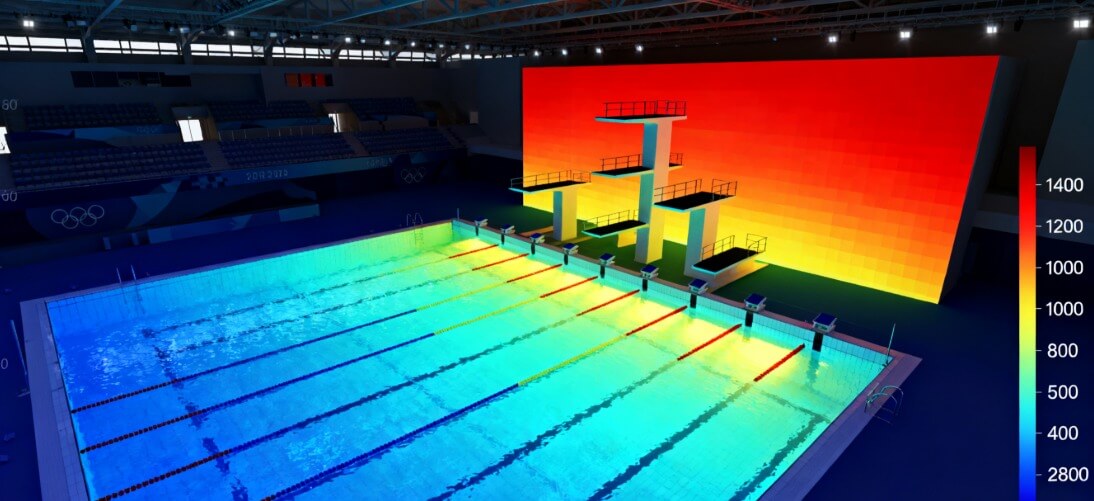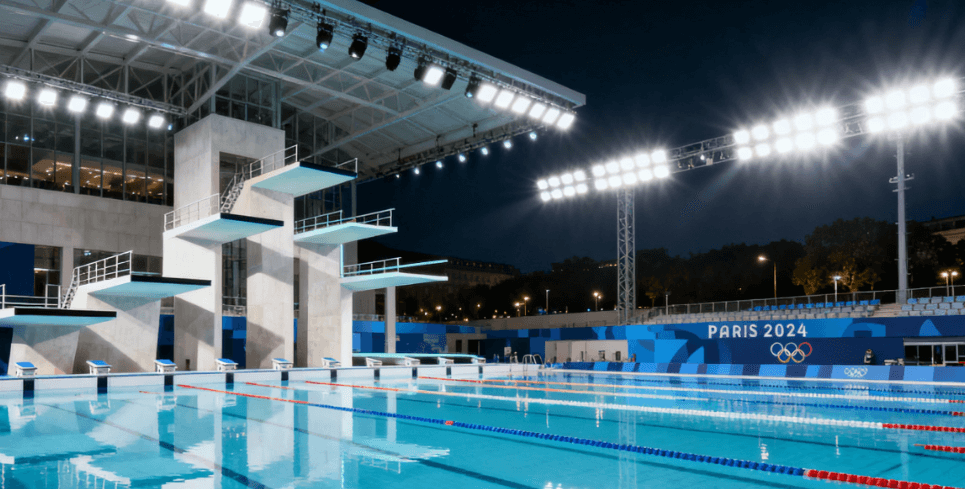Olympic-Grade LED Stadium Lights at Paris 2024 Aquatics Centre
Quick Reference: LED Stadium Lighting Specs for Paris 2024 Aquatics Centre
The following table summarizes the LED stadium lighting specifications that made the Paris 2024 Aquatics Centre broadcast- and competition-ready. These benchmarks are useful for venue designers, engineers, and operators seeking best practices in sports stadium LED lighting.
| Parameter | Paris 2024 Aquatics Centre Target | Purpose / Notes |
|---|---|---|
| Average Vertical Illuminance (Ev) | 1,400–1,600 lux (on camera-facing planes) | Ensures broadcast-grade visibility for OBS and high-frame-rate cameras. |
| Horizontal Illuminance (Eh) | 1,000–1,200 lux (pool deck & diving zones) | Provides athlete safety and spectator clarity in competition areas. |
| Uniformity Ratio (U1, Ev/Eh) | ≥ 0.7 | Maintains even coverage across lanes, boards, and field of play. |
| Correlated Color Temperature (CCT) | 5,600 K ± 300 K | Matches daylight balance for broadcast, ensuring natural skin tones on camera. |
| Color Rendering Index (CRI) | ≥ 90 | Guarantees accurate color reproduction for athletes, water, and venue branding. |
| Driver Performance | Flicker-free, > 2 kHz high-frequency modulation | Prevents slow-motion flicker and temporal artifacts during broadcast replays. |
| Glare Control | Asymmetric optics + shielding | Protects athlete sightlines and reduces specular water reflections. |
| Sustainability Factors | Low power density (< 15 W/m²), PV integration, reusable overlay rig | Supports energy efficiency, reuse, and reduced carbon footprint. |
The Paris 2024 Olympic Aquatics Centre proved how far modern LED stadium lights have come in delivering Olympic-standard performance. Tasked with meeting the triple challenge of athlete visibility, broadcast excellence, and sustainable long-term operation, the lighting project combined permanent sports venue luminaires with a temporary broadcast "overlay" rig operated by SLX. This dual approach allowed the venue to satisfy Olympic Broadcasting Services (OBS) requirements while also supporting the Centre's community role post-Games.
For the first time at this scale, sports stadium LED lighting was implemented as a modular system designed to meet both elite competition and legacy use. The Paris 2024 model is now being referenced globally as a new standard for aquatics and indoor sports venues.
Lighting Design Principles for Aquatic Sports

Lighting water-based sports is uniquely complex. Reflections, high-speed movement, multiple camera angles, and athlete sightlines all need to be balanced in one integrated scheme. At Paris 2024, LED stadium lighting design followed four key principles:
Dual-area illumination
Separate vertical and horizontal lux targets were applied to competition pools and diving platforms. Photometric modelling (using IES files and 3D simulation renders) ensured both athletes and cameras received consistent, broadcast-ready light levels.Glare suppression & sightline protection
Fixtures were positioned with asymmetric optics to eliminate overhead glare for swimmers and divers. Angled rigging and masking techniques ensured light never entered athletes' eyes or obstructed broadcast camera views.Reflection control for water surfaces
Designers carefully modelled light incidence angles to minimize distracting surface glare and specular reflections from moving water — a crucial factor in diving and synchronized swimming events.Layered lighting for multiple audiences
The scheme was calibrated not just for athletes, but also for in-venue spectators and global broadcast cameras. Preset modes allowed quick transitions between Olympic finals, warm-ups, and community use.
The result was a uniform, flicker-free, and visually comfortable environment that worked seamlessly for every stakeholder.
LED Stadium Lighting Specifications & Broadcast-Ready Setup
Paris 2024 adopted a hybrid system: permanent LED fixtures for daily venue operation, complemented by a broadcast overlay to meet ultra-high standards for the Games.
High vertical illuminance
Camera-facing surfaces reached 1,400–1,600 lux with tight uniformity across pool lanes and diving boards. This was validated via photometric simulation and confirmed during OBS commissioning.Consistent color temperature
Fixtures were aligned at ~5,000K to ensure consistent tones across multi-camera broadcasts, avoiding color shifts during live cuts or replays.Flicker-free drivers
High-frequency (>5,000 Hz) drivers ensured zero visible flicker in ultra-slow-motion replay footage. Smooth dimming curves enabled scene changes without introducing temporal artifacts.Fixture performance & rigging
High-output waterproof LED floodlights were paired with precision beam control optics. Each luminaire was simulated with its IES profile to confirm lux targets and optimize rigging loads.
Together, these specifications highlight how sports stadium LED lighting can outperform older metal halide or HPS systems, both in terms of broadcast quality and sustainability.
.png)
Broadcast Integration & OBS Compliance
Meeting OBS (Olympic Broadcasting Services) broadcast standards was non-negotiable for the Paris 2024 Aquatics Centre. With billions of global viewers depending on crystal-clear coverage, every element of the lighting design had to exceed international benchmarks for professional sports broadcasting. The venue achieved compliance through meticulous attention to three critical factors:
Vertical lux & gradients – The LED stadium lights were calibrated to provide precise vertical illuminance across athletes, swimming lanes, and diving platforms. This ensured that 4K and HDR cameras captured balanced brightness, avoiding underexposed areas or excessive glare. Even in dynamic movements, athletes remained evenly lit, enhancing both visibility and broadcast clarity.
Uniformity ratios – Consistency was key to producing broadcast-ready visuals. Engineers designed the sports stadium LED lighting layout to achieve uniform light distribution across reflective water surfaces and elevated dive platforms. This minimized luminance variation, preventing distracting hotspots or shadowed zones and ensuring smooth, professional-quality images throughout live coverage.
Temporal stability – To meet slow-motion and high-frame-rate broadcast requirements, the system was rigorously tested for flicker across all dimming levels. Ceramiclite's advanced LED stadium lights technology delivered stable, flicker-free illumination, verified by comprehensive on-site testing with broadcast cameras.
Together, these measures allowed the Aquatics Centre's LED stadium lights to deliver flawless, broadcast-grade visuals. From athletes’ facial expressions to the crisp contrast of lane markers under water, every detail was captured with precision—bringing the excitement of Paris 2024 to billions of viewers around the world without compromise.
Venue Operation, Sustainability & Legacy
Unlike previous Olympic Games, Paris 2024 placed strong emphasis on long-term venue legacy and sustainability. The lighting strategy was carefully designed to balance short-term event needs with long-term community benefits:
Overlay vs. permanent system – To meet Olympic Broadcasting Services (OBS) requirements, SLX deployed a temporary rig that could handle the demanding broadcast lux levels. Once the Games concluded, this overlay was dismantled and redeployed for other international events. At the same time, the Aquatics Centre retained its permanent high-performance LED stadium lights, ensuring efficient daily operations for training, competitions, and public use.
Energy efficiency – By replacing traditional luminaires with modern LED stadium lights, the venue cut electricity consumption by more than 40%, a saving amplified by reduced HVAC cooling loads since LEDs generate less radiant heat. This not only lowered operating expenses but also reduced the building’s overall carbon footprint.
Sustainability focus – Temporary systems were designed with repurposing in mind, allowing them to be reused for future global sporting events. The permanent fixtures were built with modular components, enabling upgrades, resale, or recycling at the end of their lifecycle. This circular design philosophy set a new benchmark for responsible sports infrastructure.
Together, these decisions underscored Paris 2024's ambition to host the most sustainable Olympic Games in history—showcasing how cutting-edge LED stadium lighting can contribute to both event excellence and long-term community value.
Design Takeaways for Other Sports Venues
The Paris 2024 Aquatics Centre offers replicable lessons for other stadium and arena projects:
Model before installation — Use 3D photometric simulations to predict reflections, glare, and uniformity.
Design for multiple audiences — Plan layered lighting for athletes, spectators, and broadcasters.
Validate flicker-free drivers — Test temporal light stability for high-speed broadcast conditions.
Prioritize reusability — Select fixtures that can be repurposed, resold, or adapted for community use.
These strategies make LED stadium lighting not only a performance choice but also a sustainability strategy.
Conclusion: New Bar for LED Stadium Lights
The Paris 2024 Olympic Aquatics Centre demonstrated how LED stadium lights and advanced sports stadium LED lighting design can balance elite performance, flawless broadcast delivery, and environmental responsibility. By combining precise glare control, photometric modelling, and sustainable planning, the venue has become a blueprint for future stadiums worldwide.
For any arena or aquatic centre seeking to modernize, the Paris 2024 project shows that LED stadium lighting is the gold standard — delivering superior athlete visibility, broadcast-ready conditions, and long-term energy savings.

